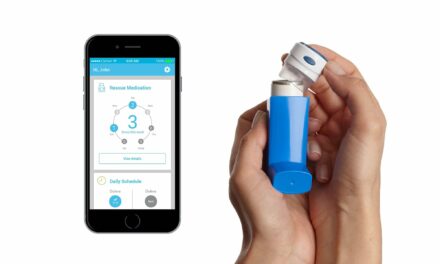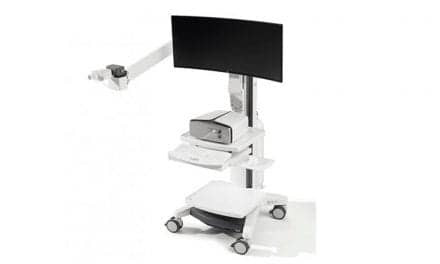A focus on home care solutions and the development of lightweight, portable oxygen delivery devices have had a major impact on the oxygen therapy market.
Oxygen therapy covers a broad range of therapy devices, including oxygen concentrators, regulators, delivery devices, interfaces and masks, and many more. Because oxygen is one of the most utilized treatments in healthcare, industry changes—including a focus on home care and new reimbursement protocols—have resulted in a great deal of innovation in the market.
To gain additional insight into these products, RT Magazine recently spoke with industry experts about the segment’s advancements, news on their most recent oxygen devices, and what RTs can expect from the future of oxygen therapy. Contributing to the discussion this month were:
- John Barnes, vice president of Sales & Product Development, Western United States, for Southmedic Inc;
- Eli Diacopoulos, vice president, general manager, Home Respiratory, Philips Respironics;
- Joe Lewarski, vice president of Clinical Affairs, Invacare Corp
RT: As far as technological trends, what’s new right now in your segment of oxygen therapy? Have these trends been driven by economics or therapy?
John Barnes (Southmedic): The trends we have seen in oxygen therapy the last several years have been driven by both economics and therapy. With the implementation of the Affordable Care Act beginning this year, new dynamics in patient care are now tied into hospital reimbursement. Acute care facilities are being evaluated for patient safety, patient comfort and satisfaction, and readmissions.
Oxygen is one of the most prescribed medications in healthcare, so respiratory care will play a key role in helping the hospitals address these new criteria. Technology in oxygen interfaces has been developed that helps respiratory therapists address these guidelines.
In addition, we have seen efforts in new products to reduce pressure ulcers and the risk of aspirations caused by oxygen interfaces as hospitals are no longer being reimbursed for nosocomial infections. Oxygen therapy products that address these issues and solve these problems will be the products of the future.
Eli Diacopoulos (Philips Respironics): Portable oxygen concentrators (POCs) continue to be the evolving trend in oxygen therapy. These devices enable the user to be more active and mobile while continuing oxygen therapy. Home care providers are increasingly deploying POCs to shift to a nondelivery model and to also satisfy patient demands. POCs offer patients more mobility and freedom to pursue interests outside of the home.
Joe Lewarski (Invacare): The biggest trend in the home oxygen space is the intense focus on nondelivery oxygen systems, primarily systems such as the Invacare HomeFill System, as well as the various portable oxygen concentrators.
We believe these trends are driven in large part by the economics of home oxygen therapy, along with the growing patient and caregiver awareness of lightweight ambulatory oxygen systems. The economic side is pretty straightforward: the new, extremely low oxygen reimbursement rates caused by the NCB (National Competitive Bidding) Rounds 1 and 2 make the entire home oxygen delivery process cost prohibitive.
For the patient and caregivers, the new oxygen technologies empower them to be highly ambulatory and independent, no longer limited by a rationed number of cylinders and waiting for deliveries.
RT: Tell us about some of your company’s most recent oxygen therapy products. What makes them innovative?
Diacopoulos: The newest Philips Respironics oxygen product is the SimplyFlo stationary oxygen concentrator—the smallest and lightest stationary concentrator available. Patients who only use oxygen at night or during sleep are able to leave home more frequently and easily with SimplyFlo. Without a light, highly portable oxygen concentrator, patients who have an extended stay away from home must either transport their heavier 30-pound stationary concentrators with them or go without. Weighing in at less than 10 pounds, the SimplyFlo makes it easier for patients to transport the concentrator, which leads to continued use of therapy, more mobility, and more active patients.
Lewarski: Our core oxygen products today include the Perfecto2 V concentrator, the HomeFill system, the XPO2 portable concentrator, and the SOLO2 portable concentrator.
The Perfecto2 V Concentrator is our most sophisticated and best performing stationary concentrator developed to date. It utilizes the state of the art, highly efficient zeolite sieve material, a proprietary compressor, and onboard monitoring and diagnostics that deliver a high purity output at all five settings, including when stressed by heat and altitude. With the onboard O2 sensor and diagnostics, routine home preventive checks are limited to every 3 years.
The HomeFill System continues to be the greatest oxygen technology breakthrough in the last decade. The durability and performance of this system have been unmatched by any modern home oxygen technology.
When used with a choice of 11 different size and weight cylinders, ranging from two to seven pounds, patients get a range of 2 to 12+ hours of portability (with a typical conserving device at the two setting). With our introduction of HomeFill cylinders using a standard 870 post valve connection, providers can use most commercially available oxygen regulators and conserving devices, providing a clinical range unmatched by any portable oxygen system.
The XPO2 and SOLO2 portable oxygen concentrators offer the ideal mix of POC solutions, both with FAA approval. The XPO2 Concentrator is a lightweight (6 pounds) pulse-dose only solution, with excellent oxygen output and delivery, which has been validated in two scientific publications.
The SOLO2 Concentrator is a robust, patient-friendly 3 LPM continuous flow and pulse-dose capable POC designed for patients with a need for continuous flow, or for those who require higher volume pulse-dose delivery. The SOLO2 performance has also been validated in scientific publications.
RT: How have portability and the demand for ambulatory oxygen solutions by patients affected therapy trends and your product development?
Diacopoulos: We are committed to innovation and developing effective products that improve the lives of those dependent on oxygen. Patient demands for lighter, quieter, and smaller products do not always fit within the reimbursement model, and patients may not be in a position to purchase the device out-of-pocket. We therefore strive to find the right balance of features that satisfy patients as well as our home care provider customers.
Lewarski: I believe that the majority of R&D in the home oxygen space is focused on highly portable, lightweight, clinical efficacious oxygen systems. The science supporting compliance to oxygen therapy and the benefits of remaining active and ambulatory, in conjunction with growing clinician and consumer awareness of portable systems, are clearly the key drivers.
RT: What impact have the Internet and direct sales to patients had on the market and the use of new oxygen products?
Barnes: The Internet has improved access to information for both patients and family members. They are actively involved in searching for better solutions for their situation.
Home care patients and their families often take a proactive attitude in trying to make their quality of life better for their chronic oxygen needs. Oxygen devices they find on the Internet educate them to other interfaces and devices.
These patients want to be comfortable, to be active, and to normalize their life as much as possible. The Internet has led many customers to Southmedic product solutions.
Diacopoulos: Similar to other products in our industry, the Internet has played a role in enabling patients to research treatment options. As a result, patients are better informed when speaking with their physicians and home care providers. Physicians will take into account both the patient’s oxygen needs and the performance of the POC in prescribing a specific product.
Patients may accept the product as prescribed by the physician and set up by the home care provider, but they may also decide to purchase another product on their own out-of-pocket, whether that is from their local provider or, in the case of Philips Respironics products, from an authorized Internet seller.
Lewarski: It’s clear that access to information and products via the Internet is changing the way consumers learn about healthcare, treatment options, and technologies. In the case of oxygen, both patients and their caregivers/family are using the Internet to purchase oxygen devices, particularly POCs and pulse oximeters. It is the beginning of a paradigm shift in healthcare consumerism and changing the way healthcare providers and manufacturers approach the market.
RT: Has your company developed relationships with hospitals or accountable care organizations (ACOs) to build a service program around your product offerings?
Barnes: Because Southmedic is a Canadian company, we use US distribution to provide our products to Acute Care, EMS, and Alternative Care.
Diacopoulos: Our products and services are applicable to the ACO objectives. We are aware of home care providers that have integrated our products and services into their contractual obligations with hospitals.
Our solutions not only provide clinically proven therapies, but also enable home care providers to better manage patient compliance in the home.
Lewarski: As a medical device manufacturer, we are not interacting directly with hospitals or ACOs.
We are studying and monitoring this space very closely to better understand the changing needs of the health systems, patients, and home care providers. This will help us to develop technology solutions aligned with the healthcare system and patient needs.
RT: How have products and technology changed in the last few years and what do you anticipate will be the future for oxygen therapy?
Barnes: We see product materials that are softer and put less pressure on the skin to reduce breakdown. The materials are also changing to eliminate chemical components that patients are allergic to and impact the environment less.
We feel that there is a real opportunity to reduce the number of interfaces needed to supply oxygen. This will help reduce cost, eliminate setup errors, and make staff work flow more efficient.
Oxygen conservation will continue to be a desired component, and we see value in products that are lightweight, comfortable, and unobtrusive for oral care and enhanced communication.
Safety will continue to be a major consideration, and interfaces that eliminate errors of low flows within a closed mask system or those that minimize setup errors will become the new standard of care.
Diacopoulos: In the past 5 years, we’ve seen considerable innovation in the area of oxygen therapy. Devices are now smaller, more portable, and designed to improve patient lifestyle.
Patient demand is driving innovation that will continue to enable the patient to be more independent.
Lewarski: Our R&D and clinical experts continue to focus on advancing the way home oxygen therapy is provided. Size, weight, oxygen production, delivery schemes, reliability, durability, and intelligence in the design are just some of the areas of focus.
We continue to look for ways to improve the user experience and enhance the patient’s quality of life, while concurrently focusing on cost-effectiveness and device performance. RT
________________________________________________________
For more information, contact [email protected].











